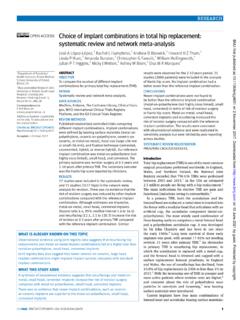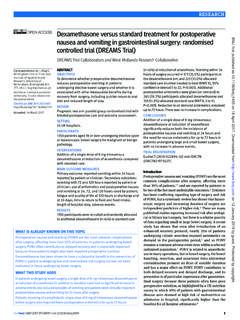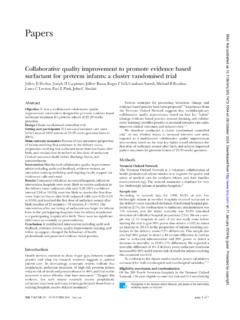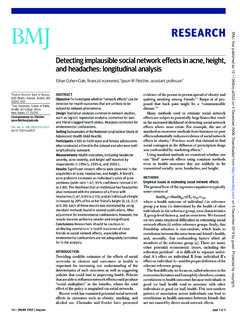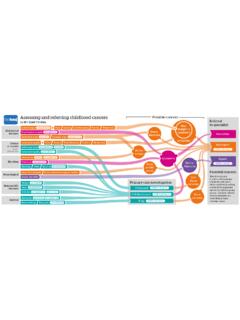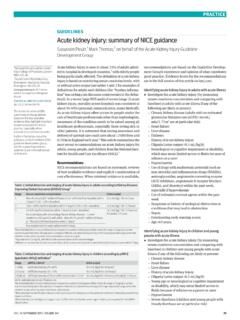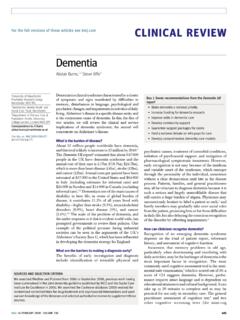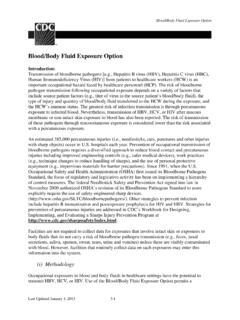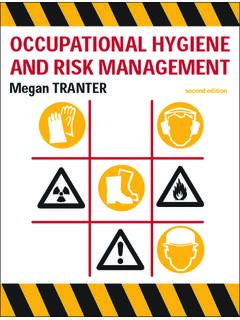Transcription of The modern diagnosis and management of pleural effusions …
1 EDUCATION CLINICAL REVIEW. The modern diagnosis and management of pleural effusions Link to this article online for CPD/CME credits Rahul Bhatnagar,1 Nick Maskell2. 1. Academic Respiratory Unit, A pleural effusion describes an excess of fluid in the pleural SOURCES AND SELECTION CRITERIA. University of Bristol, Southmead cavity, usually resulting from an imbalance in the normal We searched through PubMed, Embase, Medline, and the Hospital, Bristol BS10 5NB, UK. 2. rate of pleural fluid production or absorption, or both. Cochrane database of systematic reviews from inception to North Bristol Lung Centre, Southmead Hospital, North Bristol pleural effusions are common, with an estimated mil- April 2015 using the primary search terms pleural effusion.
2 NHS Trust, Bristol, UK lion new cases in the United States and 200 000-250 000 and indwelling pleural catheter . We included abstracts Correspondence to R Bhatnagar in the United Kingdom each This review describes published in English and related to adults. Priority was given to randomised controlled trials and meta-analyses, although how pleural effusions may be investigated and treated in Cite this as: BMJ 2015;351:h4520 citations from case series and retrospective studies have doi: the community and secondary care, with a particular focus been included where appropriate.
3 Further information on the emerging phenomenon of ambulatory management . was obtained from our personal libraries, trial registration This is an edited version of the paper. Full version and references databases (such as ), and conference on What are the most common causes of pleural effusions ? proceedings where necessary. More than 50 causes of pleural effusions are recognised,2. spanning a wide variety of medical specialties. The cause tant in terms of further investigations and long term out- is often classified initially as either a transudative or an The American Thoracic Society guidelines on the exudative process, with the former usually associated management of malignant pleural effusion, published with cardiac, renal, or hepatic dysfunction and the lat- in 2000, estimated the incidence in the US to be between ter with conditions that cause an excess of inflammation, 80 000 and 160 000 new cases each such as malignancy or infection.
4 The most common cause Despite the seemingly clear distinction between exu- of a transudate, and probably effusions as a whole, is dates and transudates, the clinical reality of determin- heart ing the cause of a pleural effusion is often much more An exudate is most likely to be associated with pneu- nuanced. Patients may present at different times along monia. Estimates suggest that up to 57% of patients with their disease course, with varying symptoms, and their pneumonia will develop pleural fluid,3 although not all condition may even have more than one contributory will require Of the other conditions that factor.
5 Careful consideration of the whole patient story may lead to an exudate, malignancy is the most impor- is vital to ensure timely and appropriate management . HOW WERE PATIENTS INCLUDED IN THE CREATION OF THIS What might be relevant in the history and when should ARTICLE? patients be referred? The structure and content of the article was discussed with How a pleural effusion presents depends on several individual patients during preparation of the manuscript. In factors such as the size of the effusion, the rate of fluid addition, these patients kindly agreed to contribute short accumulation, comorbidities, and underlying respira- descriptions of their experiences relating to their pleural tory reserve.
6 Patients routinely mention at least one of disease and treatment. dyspnoea, cough (non-productive), or chest pain (usu- ally pleuritic). The initial history should be focused on THE BOTTOM LINE determining the severity and rate of onset of symptoms pleural effusions are common and may be caused by a variety of underlying and thus the need for intervention, and an exploration illnesses of any potential causes. effusions that develop rapidly An undiagnosed unilateral pleural effusion, without a history suggestive of (over hours to days rather than weeks to months) are acute infection, should be considered malignant until proved otherwise likely to result from a limited number of causes, examples Bilateral effusions are usually due to cardiac, renal, or hepatic impairment of which include injury to the chest wall or recent chest treatment of the cause will usually improve effusions without the need for infection (parapneumonic).
7 Collections that appear more intervention slowly raise the suspicion of more chronic processes, with Chest radiography and computed tomography are vital early investigations in the presence of constitutional symptoms potentially the diagnosis of pleural effusions pointing towards empyema, malignancy, or tuberculous Both the safety and the success of pleural procedures are improved by the use pleuritis. Box 1 details other important points to address of thoracic ultrasonography to guide needle placement when eliciting a history from a patient with an effusion.
8 Clinically, findings typically include stony dullness to There is an increasing drive to diagnose and manage effusions in the outpatient setting, with pleural clinics and medical thoracoscopy streamlining percussion and reduced chest expansion on the affected the diagnostic pathway side of the hemithorax, as well as reduced breath sounds on auscultation over the effusion. An area of bronchial Indwelling pleural catheters can now allow many patients with recurrent effusions to be managed at home breathing may also be present in the region superior to the fluid.
9 26 12 September 2015 | the bmj EDUCATION CLINICAL REVIEW. suggested by changes on erect chest radiographs, mod- erate to large effusions are usually more recognisable, appearing as dense opacification, which forms the out- line of a meniscus superiorly. Large effusions may lead to the classic white-out of the affected hemithorax (fig 1). In patients with this radiographic appearance but recent imaging suggesting little fluid, or patients with a rapid deterioration in symptoms, lobar collapse should be con- sidered as an alternative diagnosis . Other tests Standard blood tests for the investigation of an effusion include a full blood count; looking for evidence of infection, blood loss, or platelet abnormality; and liver and renal func- tion to investigate for transudative causes, including hypo.
10 Albuminaemia. In those with bilateral effusions , in addition to the above investigations, procedures such as a trans . thoracic echocardiography or tests for serum NT-pro brain natriuretic peptide may be of benefit in identifying or ruling out cardiac failure as contributory, and, if performed early, may reveal a diagnosis that can be managed in primary care without the need for referral or further How might pleural effusions be investigated in secondary care? Fluid sampling A diagnostic tap is a routine first invasive step in the inves- tigation of a pleural effusion and can be carried out simply in many settings, including outpatients, by appropriately Fig 1 | Varying appearances of pleural effusion.


